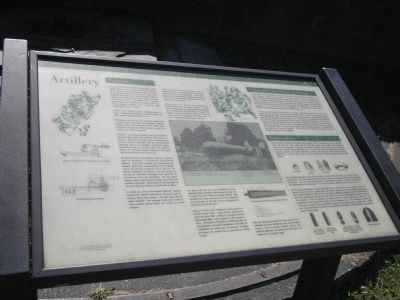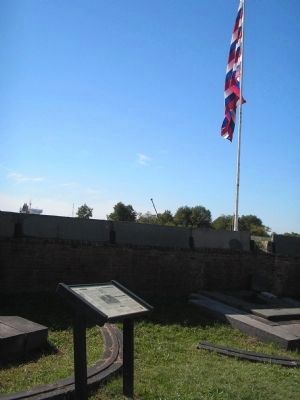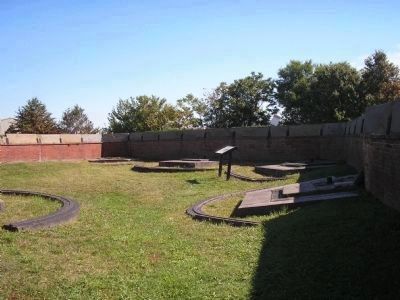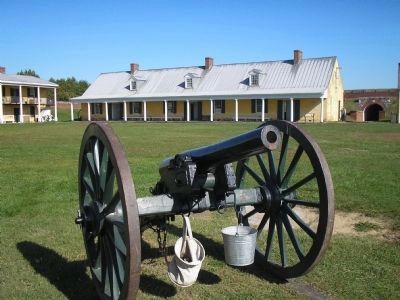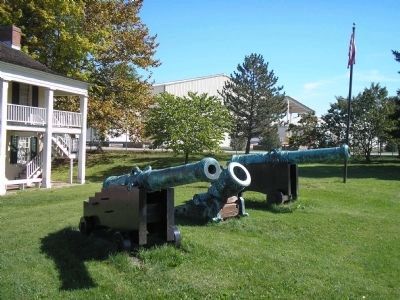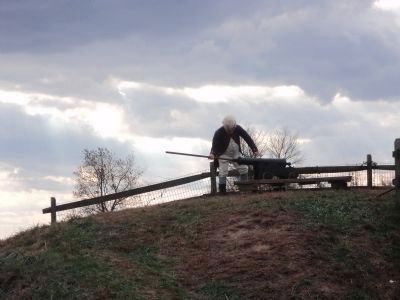Fort Mifflin in Philadelphia in Philadelphia County, Pennsylvania — The American Northeast (Mid-Atlantic)
Artillery
Cannon
During the Revolutionary War armaments at Fort Mifflin were typical of those used at all colonial forts. Cannons were the largest weapons, but due to lack of materials in America, they were acquired from France or captured from the British. Cannon of the time were actually cast in iron and had a smooth bore. All cannon were classified according to the weight of the round shot they were capable of firing. Shot or cannon balls ranged from 2 to 32 pounds.
Cannon were placed on split carriages made of wood. Standard field artillery used carriages with large wooden wheels banded by iron.
A 32 pound cannon was over 9 feet in length, had a caliber (inner diameter) of 6.5 inches, weighed 7,000 pounds, and could fire a shot 2,900 yards. Field guns required up to fifteen men in a gun crew to load, aim, and fire properly.
Seacoast or garrison artillery were permanently mounted guns that had carriages with small iron wheels. Seacoast carriages were constructed so that the recoil of the gun sent the cannon back along its rails to be reloaded. Seacoast cannon were all at least 18 pounds. After Fort Mifflin’s defeat, the British reported finding 14 field guns and 15 seacoast cannon at the fort.
American artillery production began in earnest after the Revolution. In 1794 the “First Defense System” of the new republic was established and brought about the reconstruction of Fort Mifflin. Along the earthen ramparts of the fort ten 32-pound, eighteen 24-pound, and one 18-pound cannon on seacoast carriages were mounted on mounds of earth (en barbette). On the water battery below, eight 18-pound guns were affixed to garrison carriages. These guns served through the “Second Defense System” and War of 1812.
In 1836 the “Third Permanent Defense” system armed Fort Mifflin with thirty 32-pound cannon, twenty 24-pound cannon, and nine guns on the water battery. The parapet walls were built up with treated timber when new platforms were installed.
During the Civil War, the fort was not manned for artillery defenses. The garrison chiefly guarded the prisoners housed in the casemates. Preparations began for the installation of target guns, however, and the parapet walls were reconstructed of brick and slate, as seen today.
After the Civil War, the fort was refurbished to accommodate more advanced weapons. In 1885, the old 32-pound and 24-pound guns and carriages were dismounted and returned for scrap. Five Rodman cannon and fifteen rifled and banded 42-pound guns were installed. The Rodman was one of the largest smooth-bore guns ever fired.
The size of the gun was made possible by a new manufacturing technique
that allowed the gun iron to harden from the inside out during casting. This stronger iron could withstand the force caused by the explosion of the 40 pounds of gunpowder necessary to fire the shot.
Rifling was the most important improvement in artillery after 1850. Long used in small arms (thus the term “rifle”), rifling of a weapon involved fabrication with a spiral groove in the weapon’s bore. This groove imparted a stabilizing spin on the projectile. Elongated projectiles could then be substituted for round shot. An increase of range, accuracy, and impact force resulted from rifled cannon.
Both the 42-pound and Rodman guns were on iron carriages that were affixed to and rotated around either a front or center “pintie” stone. The different platforms and pinties for these guns are visible on the ramparts today.
Erected by Fort Mifflin Historic Site.
Topics. This historical marker is listed in these topic lists: Forts and Castles • Notable Places. A significant historical year for this entry is 1794.
Location. 39° 52.532′ N, 75° 12.726′ W. Marker is in Philadelphia, Pennsylvania, in Philadelphia County. It is in Fort Mifflin. Marker can be reached from W Fort Mifflin Road, on the right when traveling east. Marker is along the walking tour of Fort Mifflin,
on the ramparts near the main gate. Touch for map. Marker is at or near this postal address: 6400 Hog Island Rd, Philadelphia PA 19153, United States of America. Touch for directions.
Other nearby markers. At least 8 other markers are within walking distance of this marker. Casemates or Bombproofs (a few steps from this marker); Main Gate / Flag (within shouting distance of this marker); Native Plants of Fort Mifflin (within shouting distance of this marker); Quartermaster’s Store (within shouting distance of this marker); What Makes Wetlands? (within shouting distance of this marker); Arsenal (within shouting distance of this marker); Expert Fishers of Fort Mifflin (within shouting distance of this marker); Fort Mifflin (Mud Fort) on Mud Island (within shouting distance of this marker). Touch for a list and map of all markers in Philadelphia.
More about this marker. The marker contains pictures of various types of cannon, such as a seacoast carriage after De Scheel and Tousard, a 32-pound seacoast cannon and a cross section of a 42-pound rifled and banded cannon. Different types of projectiles are also on the marker, including solid shot, canister, grapeshot and angles. There is also a picture of a cannon crew loading a gun, and a photograph of a Rodman cannon.
Related markers. Click here for a list of markers that are related to this marker. This series of markers follow the walking
tour of Fort Mifflin.
Also see . . .
1. The Fort that saved America. The Official Website of Fort Mifflin on the Delaware. (Submitted on October 21, 2008, by Bill Coughlin of Woodland Park, New Jersey.)
2. Fort Mifflin Groundplan. Layout of Fort Mifflin, the Fort that saved America. (Submitted on October 21, 2008, by Bill Coughlin of Woodland Park, New Jersey.)
Credits. This page was last revised on February 2, 2023. It was originally submitted on October 21, 2008, by Bill Coughlin of Woodland Park, New Jersey. This page has been viewed 2,073 times since then and 27 times this year. Photos: 1, 2, 3, 4, 5. submitted on October 21, 2008, by Bill Coughlin of Woodland Park, New Jersey. 6. submitted on January 12, 2014, by Bill Coughlin of Woodland Park, New Jersey.
